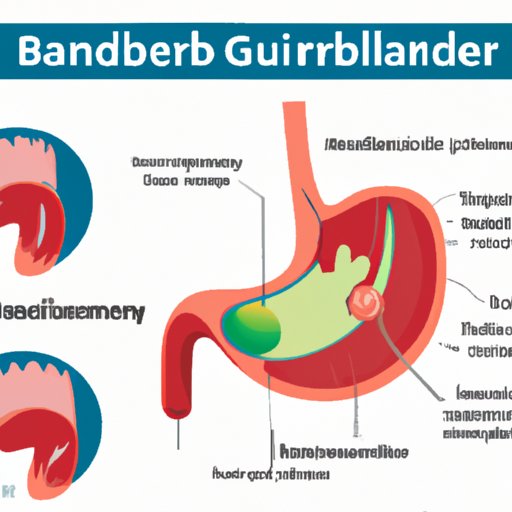
I. Introduction
The gallbladder is a small organ located in the upper right quadrant of the abdomen, just below the liver. It plays an essential role in the digestive process by storing and releasing bile, which aids in the digestion of fats. While this inconspicuous organ is often overlooked, it can cause significant discomfort when it malfunctions. This article aims to provide an in-depth look at the symptoms of gallbladder issues, how to differentiate between them and other conditions, and tips for maintaining a healthy gallbladder.
II. 7 signs of gallbladder issues to watch out for
The following are the most common symptoms of gallbladder problems:
- Pain in the upper right part of the abdomen: This is perhaps the most tell-tale sign of gallbladder issues.
- Nausea and vomiting: These symptoms often accompany pain and can be particularly severe.
- Back pain between the shoulder blades: This type of pain can be a sign of a gallbladder attack.
- Feeling bloated or gassy: These symptoms can indicate a buildup of gas in the digestive system caused by a malfunctioning gallbladder.
- Diarrhea or constipation: A gallbladder problem can lead to changes in bowel movements.
- Jaundice: Yellowing of the skin and eyes can be a sign that bile ducts are blocked by gallstones.
- Fever or chills: These symptoms, while less common, can occur if an infection is present.
III. Is it gallbladder or something else? Identifying symptoms
It can be challenging to distinguish between gallbladder symptoms and those of other conditions. Acid reflux, pancreatitis, or kidney stones can all present similar symptoms. To differentiate between them, it’s essential to pay close attention to the type of pain you are experiencing. Gallbladder pain is typically sharp and located in the upper-right part of the abdomen. Pain from acid reflux, on the other hand, is often a burning sensation in the chest region that can also cause coughing or a hoarse voice. Pancreatitis and kidney stones can cause severe pain that radiates to the back or flank region.
IV. The silent symptoms of gallbladder problems you need to know
While pain and nausea are the most common symptoms of gallbladder issues, there are also several silent symptoms that you should be aware of. Fatigue, itching, or changes in the color of your stool can all be signs of a malfunctioning gallbladder. These symptoms occur because a lack of proper bile flow can lead to a buildup of toxins in the bloodstream, resulting in fatigue and itching. Changes in the color of your stool can occur because there’s not enough bile to break down the fats in your food.
V. Gallbladder dysfunction: How to recognize the signs and symptoms
To understand gallbladder dysfunction, it’s helpful to know how the gallbladder functions normally. When you eat, your gallbladder contracts and releases bile through the bile ducts into the small intestine. If the flow of bile is impeded by gallstones or inflammation, it can result in significant discomfort. Symptoms can include abdominal pain, bloating, nausea, and vomiting. Long-term gallbladder dysfunction can lead to chronic diarrhea and malabsorption issues.
VI. From nausea to pain: Understanding gallbladder symptoms
Gallbladder symptoms can manifest in a variety of ways, and it’s essential to understand what they could mean. Sharp, stabbing pain in the upper-right part of the abdomen can indicate a gallbladder attack. Chronic indigestion or bloating can lead to an uncomfortable, full feeling, and diarrhea. Constant or intermittent nausea can signal inflammation or blockages in the bile ducts. If you’re experiencing these symptoms, it’s crucial to seek medical attention to determine the underlying cause and receive appropriate treatment.
VII. Don’t ignore these signs of gallbladder disease
Ignoring symptoms of gallbladder disease can have severe consequences. Inflammation or blockages in the bile ducts can cause infections, liver damage, or pancreatitis. Gallstones can cause pancreatitis, an inflammation of the pancreas. Long-term gallbladder dysfunction can lead to chronic digestive issues, malabsorption of nutrients, and even the formation of liver cysts. If you’re experiencing any of the symptoms mentioned in this article, seeking medical attention promptly can help prevent these complications.
VIII. Listen to your body: Early warning signs of gallbladder trouble
The best way to maintain a healthy gallbladder is to listen to your body’s signals and pay attention to early warning signs. Maintaining a healthy weight, eating a balanced diet, and avoiding foods high in fat or cholesterol can all help prevent gallbladder diseases. Regular exercise, staying hydrated, and avoiding smoking or drinking alcohol can also reduce your risk. If you’re experiencing any symptoms of gallbladder issues, it’s crucial to see a doctor right away to identify the underlying cause and receive prompt treatment.
IX. Conclusion
The symptoms of gallbladder issues can be uncomfortable and debilitating, but seeking medical attention early can help prevent complications. Common symptoms include pain in the upper right abdomen, nausea, bloating, and diarrhea. Silent symptoms of gallbladder disease can include fatigue, itching, and changes in the color of your stool. Maintaining a healthy lifestyle and seeking medical attention promptly can help prevent gallbladder issues and maintain good overall health.




